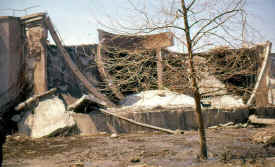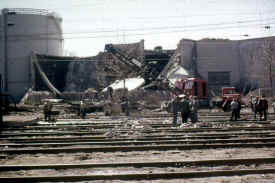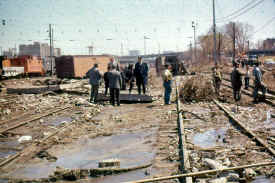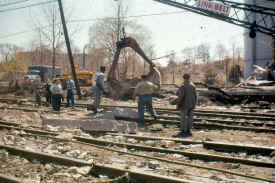|
Some know Brooklyn as the
home of Fort Hamilton, the place they took their draft physicals and were
ushered into the armed forces. Some
know Brooklyn as the final bastion of steam switcher service into the
1960's. It is memorialized
as home of the Brooklyn Dodgers and Ebbets Field.
It is the home of a recognizable accent, and the eastern side of
New York's most memorable and historic bridge.
For my father, it was none of these.
For Dad, it was the location of the biggest railroading nightmare
he faced in his 45 years of service to the Long Island Rail Road.
The nightmare was called "Bay Ridge Yard".
Bay Ridge faces the southern
side of New York Harbor, edging the Atlantic Ocean.
The Long Island owns the track, and until the 1950's, Pennsylvania
Railroad B3 electric boxcabs sorted freight cars under catenary wire, and
loading them onto car floats, to be shoved across to New Jersey and sent
on to the rest of America. With
the end of Pennsy dominance, Long Island's fleet of electric locomotives
was culled, and yard switching was handed over to Baldwin Diesels.
The wires still stood but the source of freight became the New
Haven Railroad. Trains were
lugged down over the Hell Gate bridge, most often behind the blocky,
ex-Virginian, EF-4 electrics. These
heavy locomotives often caused rails to roll or crack.
If that wasn't enough, the local youth vandalism was vicious.
Sometimes it was switch locks broken, turn-outs being thrown, and cars on
the ground. Sometimes it was
kids climbing onto the slowly passing freights, reaching up to grab the
wires, and the results catastrophic. Bay
Ridge wasn't a fun place to grow up, live, or work.
As the population of Brooklyn
grew, the City of New York had to face facts regarding living conditions.
Urban renewal meant replacing tenements and management of waste
water, which is a nice way of saying,
"What do you do with sewerage once you flush." It
couldn't be dumped in New York Harbor any longer.
Once it had been the practice that when one flushed the toilet, and
the waste disappeared, it simply was passed on waves, through a number of
subterranean brick and concrete tubes, and dumped, "sploosh",
into New York Harbor. With
a rising population and the growth of urban properties, this approach was
no longer feasible. In fact,
New York Harbor had become a dead zone.
Where sturgeon historically migrated up the Hudson River, was now
occupied only by heartier species of soft shell clams and Horseshoe crabs,
feeding on whatever settled into the muck and, in legend, the occasional
mortified gangster.
Then there was the fact that along the southern shore
of Long Island and the Coney Island beaches, evidence of human
inhabitation was washing ashore.
The response was built just
on the southern side of the Bay Ridge Yard. In the 1950, Owls Head
Waste Water Treatment plant was constructed. The sewerage plant was
a series of huge tanks, with twelve inch thick walls, built of concrete,
reinforced with steel grids. The contractor[1]
had built similar tanks in California, and they continued to function
without problems. This composition was stronger than concrete alone,
stronger than steel alone.
A modernized sewerage system
pumped the human effluent into the ten immense tanks where it was
screened, settled, digested by bacteria, made less toxic, and eventually
separated into liquid that was acceptable for release into the ocean
directed current, and solids that could be used to fertilize parks and to
cover landfills of incinerator ash and refuse picked up off the streets.
On the railroad side, next
door in Bay Ridge Yard, tugboats ferried in empty car floats and left with
barges loaded with scores of freight cars. The only connection
to the Owls Head Waste Water Plant was the ominous odor of bacterially
generated gases carried in the cooling sea breezes as land temperatures
rose during the day. The familiar "rotten egg" odor was
largely composed of hydrogen sulfide gas, which might have been a possible
clue that water absorbed by the concrete walls contained sulfides, and
sulfides were coming in contact with the steel wire in the pre-stressed
concrete. It hadn't been a source of concern in over
2,500 other tanks built in this manner, so it didn't raise concern or
suspicion at the time. And rust never sleeps.
On a night in April, 1961, it
became a major source of concern, if you were a brakeman assembling
a train, or a conductor working in a New Haven caboose, or an engine crew
suffering through that awful odor that seemed to be stronger than ever
experienced before.
In the early morning hours,
over the thrumming of Diesel engines, a grinding, groaning, cracking,
sound emanated from one of the filled-to-the-brim tanks of raw
household sewerage. What followed more or less defies human
imagination. A deluge in excess of 2,000,000 gallons, of
human effluent,[2] comprised of everything that passes down a
kitchen sink, the "S" tube of a toilet, a bath, or shower
exploded outward. Green "combers", with surfing
"bergs" of fractured rubble, overwhelmed the railroad yard.
The concrete bowl of the tank scattered itself over the tracks.
A steel New Haven caboose simply bowled over, as did loaded refrigerator
and hopper cars. The yard was
a mire of ...of... yuch! What
did not settle into pools
between the tracks, simply rushed to the car floats where it remained
dripping at daylight.

The remains of the destroyed tank.
Apparently the walls of the "bowl" were 12 inches thick, not 12
feet as stated in the N.Y. Times article
|

Crew working directly in the "flood plain" guide a bucket
over debris. Note the cap of the sewerage tank fallen into the
center of the "bowl".
|

Standing on a slab of the destroyed sewerage tank, and official
scrapes his shoe clean. A nest of reinforcement wire is snarled in
the foreground. Un-affected, a Long Island caboose and
Baldwin
switcher are seen in the back ground.
|

Two trackmen begin the slow process of collecting concrete slabs from
the tracks
|
My father, along with other
officials of the track department, got the call in the middle of the
night. For whatever reason, he
thought to carry along his Argus C3, and what you see in these pictures
is, to the best of my knowledge, the only pictorial record of what became
known as "The Great People Poop Wreck".
In the twenty-first century,
one can only imagine O.S.H.A. handling this with personnel in Haz-Mat
suits and self contained breathing apparatus.
In 1961, specialized gear called for gum rubber shoe covers for
executives, while the work crews wore the usual steel toed boots.
No doubt a great deal of laundry was done each night until the
scene was cleared of wreckage and the tracks restored.
During clean-up, the remaining treatment tanks were drained
to half-depth. The un-ending
accumulation of waste water was managed by pumping it onto barges and
towing it ten miles out to sea, where once again, out of sight meant out
of mind. Ocean currents
then reinvested the material back on the coastal shoreline.
Whether it was a build-up of
waste generated gases, a poor quality of concrete, or rusting through of
the wire mesh inside the walls, would be argued out in court well into the
summer of 1962. The tanks were
eventually drained and plated with steel.
The effect on the rail yard
was considerably different. Retired
railroaders reported that once the concrete debris was gone,
the waters evaporated, and things set to right, a garden blossomed
in the yard; vegetables! The
plants thrived. It was
not unusual to find red tomatoes, firm zucchinis, and other vegetables
growing in amongst the ties. Whether
they were harvested or not, I am unable to say, but obviously, more than a
tree grew in Brooklyn.
Today's Owls Head facility,
is sandwiched between the edge of the Belt Parkway, and the retired
railroad facility. In 2012, it still elicited odor complaints from
neighbors, but has been rebuilt and is an active part of lessening
pollution and raising water quality in the Hudson River and off-shore.
Merged into the Penn Central
and its successor Conrail, the New Haven Railroad no longer exists. Freight
is shipped over tracks of the former New York Central, without touching
Brooklyn. At Bay Ridge
Yard, the catenary wire has been sold as scrap.
The car floats and tugs are a memory.
The remaining track is used as a storage facility.
Occasionally a Long Island MTA switcher wanders into the yard to
pick up or drop off a random car.
[1] Preload
Corporation
[2] Asbury, Edith Evans; "Builder Defends His Sewage Tank", New
York Times, August 09, 1962
|